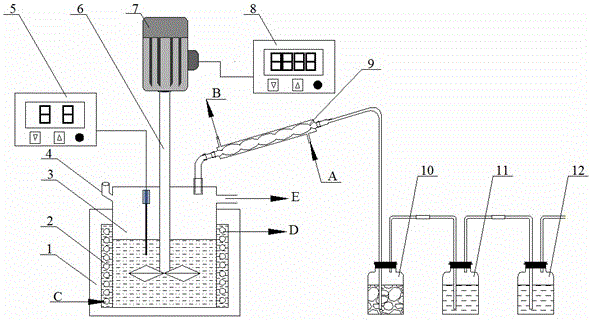A method and device for recovering zinc by leaching blast furnace gas ash by multi-ligand complex coordination ammonia method
A blast furnace gas ash and multi-ligand technology, applied in the field of hydrometallurgy, can solve the problems of poor economic feasibility, short kiln lining life, high coke consumption rate, etc., achieve high effective utilization of resources, widen research scope, operation Simple and convenient effects
- Summary
- Abstract
- Description
- Claims
- Application Information
AI Technical Summary
Problems solved by technology
Method used
Image
Examples
Embodiment 1
[0026] The multi-ligand complex coordination ammonia method for leaching blast furnace gas ash to recover zinc has the following specific steps:
[0027] Step 1, first mix sodium citrate and sodium tartrate according to a molar ratio of 1:1 to obtain a complex mixture;
[0028] Step 2. Add the compounding mixture to the pure water so that the concentration of sodium citrate and sodium tartrate in the compounding mixture is 0.2 mol / L and 0.2 mol / L. After stirring evenly, add ammonia solution and sulfuric acid in a molar ratio of 1:1 Ammonium, mixed evenly to form a coordination leaching agent, control the total ammonia concentration in the coordination leaching agent to 7mol / L, then add the blast furnace gas ash and the coordination leaching agent to the reaction vessel successively according to the solid-liquid ratio of 1:5g / ml Leaching, during the leaching process, the reaction temperature is controlled at 30°C, the stirring speed is 300r / min, and the leaching is performed fo...
Embodiment 2
[0034] The multi-ligand complex coordination ammonia method for leaching blast furnace gas ash to recover zinc has the following specific steps:
[0035] Step 1, first mix ammonium citrate and tartaric acid according to the molar ratio of 3.5:2 to obtain a complex mixture;
[0036] Step 2. Add the compound mixture to the pure water, so that the concentration of ammonium citrate in the compound mixture is 0.35mol / L, and the concentration of tartaric acid is 0.2mol / L. After stirring evenly, add ammonia solution and ammonium sulfate with a molar ratio of 10:1. , form a coordination leaching agent after mixing evenly, control the total ammonia concentration in the coordination leaching agent to 7mol / L, then add the blast furnace gas ash and the coordination leaching agent to the reaction vessel successively for leaching according to the solid-to-liquid ratio of 1:5, and leaching The process controls the reaction temperature to be 30°C, the stirring speed to be 300r / min, and leachi...
Embodiment 3
[0042] The multi-ligand complex coordination ammonia method for leaching blast furnace gas ash to recover zinc has the following specific steps:
[0043] Step 1. First, mix citric acid and tartaric acid according to a molar ratio of 5.5:2 to obtain a complex mixture;
[0044] Step 2. Add the compound mixture to the pure water, so that the concentration of ammonium citrate in the compound mixture is 0.55mol / L, and the concentration of tartaric acid is 0.2mol / L. After stirring evenly, add ammonia solution and ammonium sulfate with a molar ratio of 5:1. , form a coordination leaching agent after mixing evenly, control the total ammonia concentration in the coordination leaching agent to be 7mol / L, then add the blast furnace gas ash and the coordination leaching agent to the reaction vessel successively for leaching according to the solid-to-liquid ratio of 1:5, and leaching The process controls the reaction temperature to be 30°C, the stirring speed to be 300r / min, and leaching f...
PUM
 Login to View More
Login to View More Abstract
Description
Claims
Application Information
 Login to View More
Login to View More - Generate Ideas
- Intellectual Property
- Life Sciences
- Materials
- Tech Scout
- Unparalleled Data Quality
- Higher Quality Content
- 60% Fewer Hallucinations
Browse by: Latest US Patents, China's latest patents, Technical Efficacy Thesaurus, Application Domain, Technology Topic, Popular Technical Reports.
© 2025 PatSnap. All rights reserved.Legal|Privacy policy|Modern Slavery Act Transparency Statement|Sitemap|About US| Contact US: help@patsnap.com

